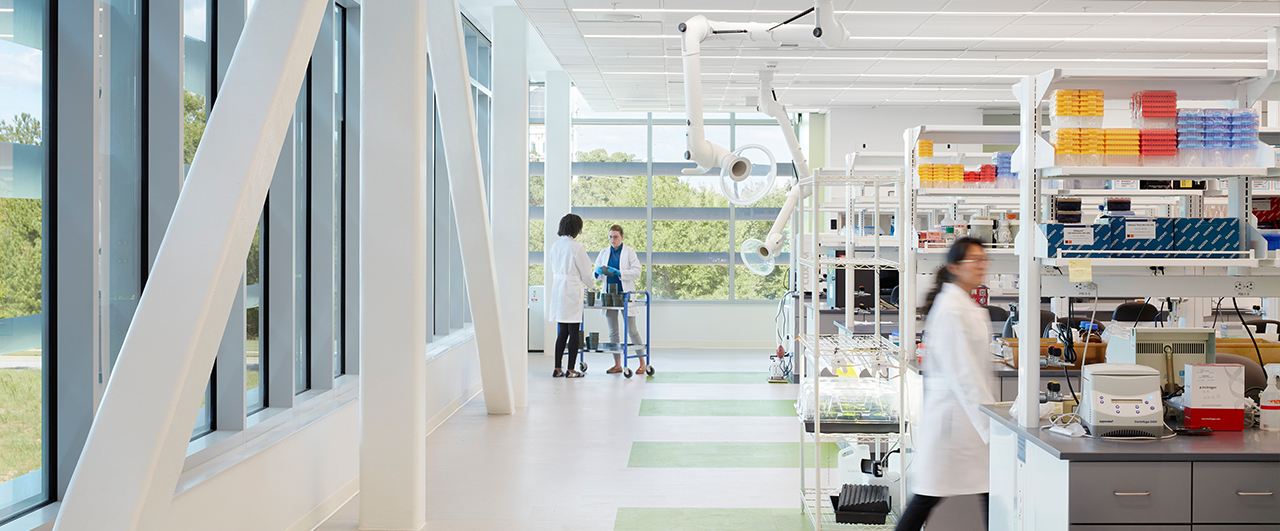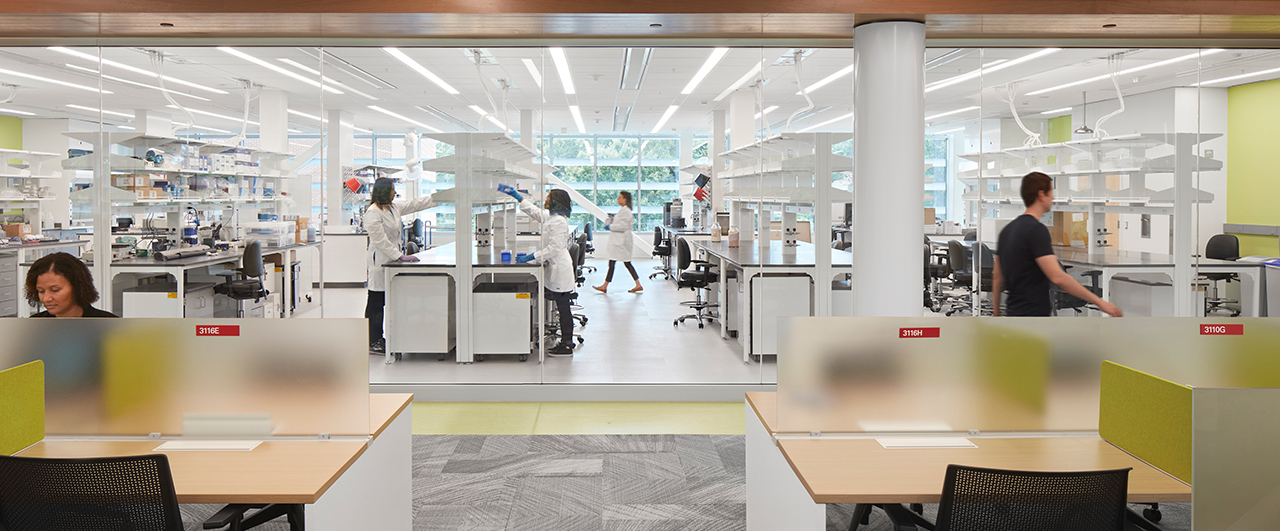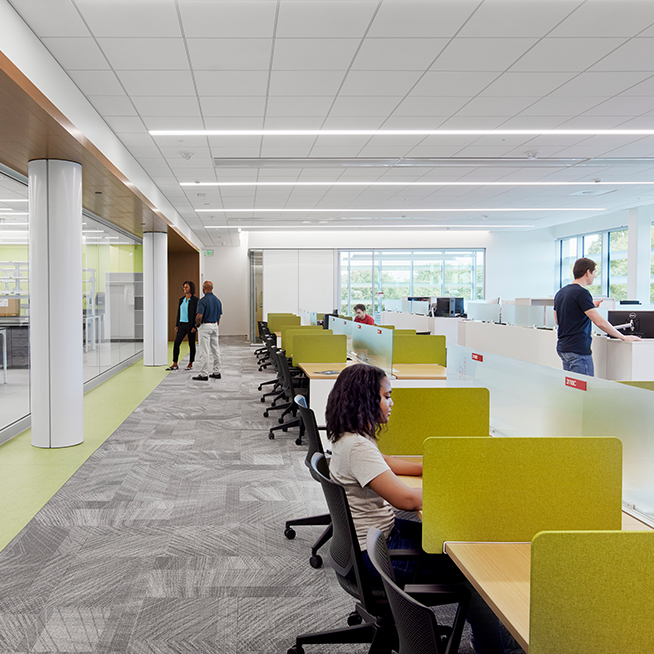
As part of an ongoing series, we recently sat down with members of Flad's science and technology team to discuss the future of the scientific workplace.
The Hypothesis:
conversations on scientific
research environments
Budgeting and Advocating for Sustainability, Designing for Wellness
As part of an ongoing series, we recently sat down with members of Flad's science and technology team to discuss the future of the scientific workplace.

Kimberly Reddin
AIA, LEED AP BD+C, WELL AP
Principal, Director of SustainabilityKimberly believes that as architects, we have a responsibility to our clients, users, and communities to create beautiful,
high-performing, healthy environments. She has dedicated her career to advocating for and building sustainable architecture that fulfills this
responsibility. The driving force behind her work is the belief that good design improves communities and helps both current and future generations to flourish.
Q: What are some of the biggest trends/challenges clients are asking about?A: From my vantage point the biggest trend, and also challenge, is the effort our clients are making to drive down their greenhouse gas emissions, waste generation, and water consumption. Historically, all those things have been high in the world of research because of safety protocols, and the operational procedures required to run a lab safely and effectively have been, in some ways, diametrically opposed to having a minimal environmental footprint.
But I think everybody recognizes that we can't just keep operating the same way we always have because it's causing significant environmental issues. Our clients are really grappling with keeping their labs running safely, not compromising the science for the sake of sustainability, while at the same time, finding ways to implement different operational practices that reduce their footprint.
Because the amount of pollution and environmental damage we've seen thus far is having an impact on weather and climate disasters, the other trend I'm also seeing more of is the concept of resilience planning. This past year has been pretty demonstrative of some of the challenges we'll be dealing with moving forward. We had major heat waves in parts of the world, droughts, flooding, and the wildfires in Canada caused days with terrible air quality here in Madison, as well as other parts of the country.
So, I think resilience is starting to be more top of mind for our clients, trying to understand what they can do to not only to be more sustainable, but to make their organizations more resilient. Some of our clients are taking it a step further and working to make their communities more resilient, which I think is really admirable.
Q: From a sustainability standpoint, what is the biggest lab planning and programming challenge you've encountered recently?A: I think everything seems to be moving in the right direction, but is it moving fast enough? That's my big concern.
One of the biggest challenges right now is I'm not seeing the lab-specific finishes, equipment, and furniture keep pace with general industry progress. A lot of manufacturers focused on lab materials and products have not seen a big demand for sustainability purchasing criteria, so we find ourselves trying to advocate for more options or transparency data. Innovation in labs can be another challenge – we work on a lot of critical facilities, so we need equipment that can reduce operational emissions but is also field tested and proven to work.
In some instances with lab finishes and furniture, we're the first to ask a manufacturer to share their VOC emissions evaluations. If the market doesn't appear to have a demand from their perspective, then the products won't keep pace. Whereas when we look at office materials, that's not a problem. Sustainability with office spaces has been a big deal for 20-some years now, but with labs, I think we're just starting to get there.
So, I think the challenge is making sure manufacturers know that we want materials and equipment for labs that incorporate healthier materials, contribute to a circular economy, and have reduced embodied and operational emission impacts. If they recognize that the demand is out there, I'm confident manufacturers will help us achieve these things.
Q: What reactions are you seeing from clients in terms of the financial aspect if some of these new technologies or sustainable solutions are not yet the most cost-effective choice?A: I've definitely been beating the drum lately that this needs to be talked about in the strategic or master planning phases before we actually have a building, so when a client is planning on funding a building project, it's built into the budget.
If the client already has the funding in place and the funding does not reflect a building that's highly sustainable, there are best practices we can implement that are cost neutral and we can make work on a relatively limited budget, but there's not that much that we can do to really take it to that next level.
On some projects, we're looking at on-site renewables, energy-reduction strategies, and water-reduction strategies that can add several million dollars or more in additional costs, depending on the project size. It's not a small cost if you want to really take it as far as you can. So, it really needs to be built into a project budget, and the only way that happens is if you plan for it up front.

Q: What trends are you seeing from a policy standpoint? Anything that you expect to see more of?A: One of the things that we're tracking is individual municipalities that are adopting stronger energy codes and other sustainability-related codes.
We see it more on the East Coast and the West Coast. California has CALGreen, which was one of the codes that helped lead the way for states to start adopting more stringent requirements around energy code and materials. New York City has Local Law 97, which will require buildings over 25,000 square feet to start meeting energy efficiency and greenhouse gas emissions criteria.
I think we'll see more and more of that. If individual municipalities don't feel their states are upgrading codes quickly enough, then I think they'll take it upon themselves to create their own codes or adopt stretch codes if they can. I think, especially on the coasts, we'll continue to see some big progress in local policy that will drive things forward and that will eventually help everyone out.
Getting back to those manufacturers seeing a market demand, if manufacturers have a product you can't specify for a project in California or New York because it doesn't comply with code restrictions, then that requires them to evolve because those are two major markets that you don't want to be eliminated from because you don't have a compliant product.

I think, especially on the coasts, we'll continue to see some big progress in local policy that will drive things forward and that will eventually help everyone out.

Q: We're starting to see more buildings designed with all electric utilities. Do you think that is the direction everything is headed?A: I think so. Again, getting back to emissions, Scope 1 are the emissions generated directly by an organization, such as emissions from a gas boiler, while Scope 2 are emissions from purchased energy, likely the local utility provider. If you can eliminate everything on site that burns fossil fuel, then you've eliminated Scope 1 for the building, which is a big goal for a lot of entities.
Meanwhile, as your utility provider's grid gets cleaner, your Scope 2 emissions decrease. If you can procure carbon-free electricity for the building, then you can eliminate both Scope 1 and 2 emissions, which is a really big deal for labs.
Then Scope 3, I always say, is like the white whale because it's everything else and hard to track, but companies are doing it.
So, I do think electrification is where we'll be headed. It's still a challenge in labs because we're just not fully comfortable with the electrified versions of some equipment yet. The other thing is sometimes it takes quite a bit of electrical power to run a piece of equipment, so it can be more expensive and potentially generate more emissions if the electrical power procured is not very clean.
Let's say you're in Madison, and you electrify everything, not only is it more expensive, but you might actually see higher emissions because our grid is not very clean. So that becomes a balancing act to determine the right thing to do based on where we are today. You need to look at what the utilities are doing and where we're going to be in a few years and ask what's really the most sustainable choice? Because unfortunately, it's not always what you think it'll be when you do the math.
But if you're in San Francisco or Seattle right now, going all electric, from an emissions standpoint, makes a lot of sense because the grids are getting cleaner and cleaner. Then your emissions are drastically reduced.

Q: How do you envision a lab will be different 10 or 20 years in the future?A: One of the things we talk about a lot is wellness. Thinking about the labor shortage we might face in the future and the way people approach work today, I think it will be critical that we design or renovate buildings to really take wellness into account.
We should be thinking about mothers' rooms, respite spaces, physical accessibility, and neurodiversity. Do we have enough daylight, and is it good daylight? Looking at the materials we're putting into a building, are there chemicals that we really shouldn't be exposing people to?
I think we're starting to get better and better data around that, and now there are more readily accessible air quality monitors. We installed air quality monitors in our San Francisco office, and we can monitor what activities seem to cause VOCs to spike and what we can do to try to make sure everyone has the best air quality possible.
All these technologies and design approaches are evolving, and I think that they'll continue to evolve along with the sustainability component because they're all tied together.
When I imagine the lab of the future, in a utopian vision, I imagine biophilic materials: wood, plants, green walls, great views, a sense of community and connection – all things that make a person feel as healthy and happy as their environment can help them feel.
I think that's really part of what design is going to turn into. A decade ago, labs felt much more sterile and focused only on function.
Flad has done a great job to bring a sense of beauty and design into even the most technically and functionally challenging labs so that there is that sense that a human occupies the space and should be accommodated.
I'm really hopeful that this trend is going to continue, and we're going to see labs that are focused not just on science, but the wellness of the lab occupants.

Thinking about the labor shortage we might face in the future and the way people approach work today, I think it will be critical that we design or renovate buildings to really take wellness into account.
Q: The younger generations seem likely to push that trend forward.A: I agree, and the research is there. When my parents started working, I don't think anybody cared that much whether workers were happy, if their job was fulfilling, or if the spaces they occupied were healthy for them.
I don't think anyone considered that sitting in a room all day with no windows and fluorescent light bulbs might be detrimental to your health. Whereas now we have all sorts of research that indicates that just isn't good for anybody, and the good thing is that healthy design is synergistic with sustainability. I think if these things continue to evolve together, we should continue to see some beautiful science spaces.
Share your thoughts or questions on these topics or others you'd like to hear our experts address. Email us 